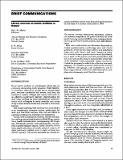Library services at health facilities in Kenya
View/
Publication Date
1993-01Type
Article, Journalviews
downloads
Metadata
Show full item recordCitation
Mbatia EW, Muya EW, Nordberg EM. Library services at health facilities in Kenya. Bull Med Libr Assoc. 1994 Jan;82(1):67-9. PMID: 8136764; PMCID: PMC225863.
Abstract/
INTRODUCTION Rural health workers in sub-Saharan Africa face an extremely demanding work situation. Their relatively brief basic training is usually ten to twenty years past, resource constraints are severe, and they are isolated in remote villages and towns with little or no effective supervisory support. Opportunities for post-basic training are poor, professional communication with colleagues is rarely possible, and access to up-to-date medical books and journals is extremely limited. Self-taught learning with the help of a local library is an increasingly attractive option, particularly for mid- and low-level workers who can not afford to purchase professional literature for themselves. Kenya, with a population of about twenty-one million and a gross national product of $340.00 per capita, has a health infrastructure encompassing 269 hospitals, 299 health centers, 1,555 dispensaries, and several hundred mission clinics. Public libraries, which have small collections of health material, exist in all eight provincial capitals and in eight of forty-two district capitals. This article describes the library situation at seventy-seven rural Kenyan health facilities on the basis of a survey conducted in 1988. METHODOLOGY The survey covered forty-seven provincial, district, and mission hospitals in all parts of Kenya, six rural health training centers (RHTCs), four nursing schools, twelve government health centers, and eight dispensaries. Data were collected by two librarians. Methods included questionnaires combining open and closed questions, direct on-site observations, and structured interviews with library staff and a sample of users. Six hundred sixteen questionnaires were distributed, and a total of 85 doctors and 405 paramedical staff who were physically present and available at the time of the librarian's visit responded. Topics covered included the purposes for which the collection was used, adequacy of available material, demand for services by different user groups, user expectations, and library organization. Interviews and observation took place simultaneously at all facilities visited.
Subject/
Rural health workers; Sub-Saharan Africa; Librarian; Journals; Rural health training centers
Collections
- General - GEN [367]

